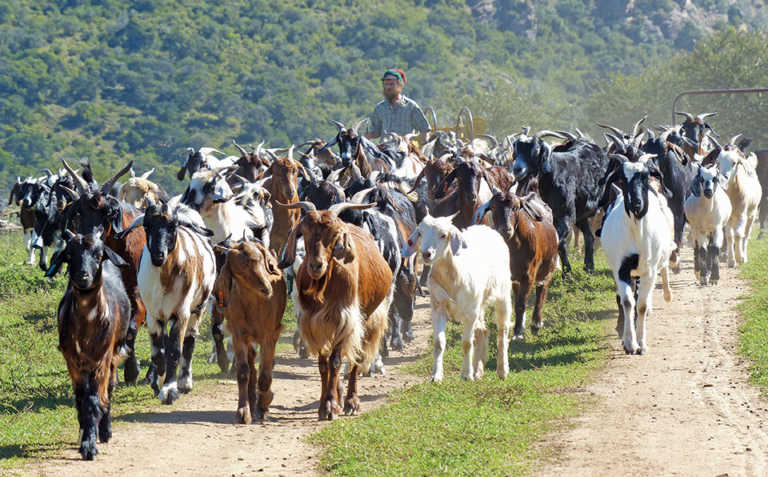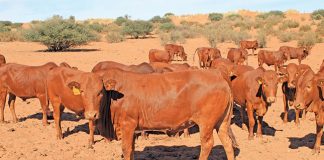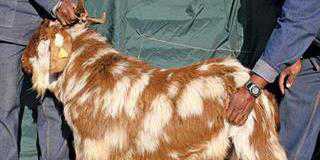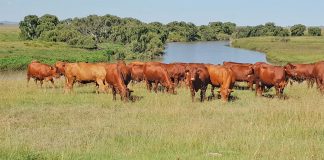
Photo: Mike Burgess
Ross Rayner had his first experience of goat farming in 2006 when he was offered an opportunity to manage a flock of ‘improved’ goats for Neville Keevy in the Adelaide district.
In 2007, Ross introduced a Xhosa Lob-eared goat (XL) ram to his own flock of about 25 maiden ewes from a respected goat breed and was astonished by the resulting crop of goats.
Recently qualified as a senior Indigenous Veld Goat (IVG) breed inspector, Ross says: “The kids were so much more lively and healthy. They were up and drinking five minutes [after birth] and we had no losses.” In partnership with his father Roger, Ross has increased his Zibhokwe IVG flock to about 100 breeding females, and is optimistic about the future of the breed.
“I don’t think we’ve even scratched the surface of the potential of IVGs,” he says. “We have a long way to go.”
Turning to IVGs
In 2007, after Ross’s grandfather Donald Walter died, his mother Jean inherited the right to use certain parts of the farm Walkersvale in the Mankazana Valley. This gave Ross and Roger an opportunity to set up a partnership and launch a fledgling livestock business.
A Farmer’s Weekly article about Lionel Whittal’s Mbuzi goat herd at Bolo in the Eastern Cape inspired the father and son team to look into what ecotype would best suit their own environment and budget. The Mbuzi is an IVG ecotype. An ecotype is a genetically distinct race within a species.
Ecotypes display phenotypical (visual) differences that develop because of changed environmental conditions due to geographic separation. The Rayners opted for the larger, more robust XL goats, historically known to occur in parts of the former Ciskei, where they adapted to browsing the varied thorn and bushveld of this rugged region.
Solid genetic foundation
Ross and Roger decided, from the beginning, to source top quality genetics. In this respect they were fortunate to be situated close to well-known Fort Beaufort IVG goat breeder John Sparks, from whom they have bought the vast majority of their foundation XL genetics.
In 2011, Ross loaned an XL ram from John that was sold a year later for the record price of R40 000 at the national IVG sale in Bloemfontein.
”I have some top quality progeny from this ram in my herd, including two young rams. I consider him to be a ‘flagship’ for our breed,” says Ross. He also bought one of his flock’s most influential foundation ewes from John, eventually selling it for R5 000 at the 2012 IVG Nationals, along with a ram that fetched R10 500.
Commercial concerns
Despite a buoyant stud market, the Rayners’ ‘bread and butter’ income comes from the traditional slaughter market in the Eastern Cape, and they supply a vibrant market in rural and urban areas with kapaters (castrated rams).
Traders from as far away as East London and King William’s Town can be seen entering Walkersvale at the peak buying season of June/July and November/December.
According to Ross, these traders have a keen eye for animals with good conformation and outstanding carcass characteristics – important selection criteria in the Zibhokwe flock.
However, Ross is quick to point out that selecting for good depth or muscled hindquarters should never be done at the expense of the IVG’s greatest assets – functional efficiency and fertility.
“There’s a balance between taking kilogram per hectare into account, and not compromising on functional breeding traits,” he explains. “You don’t want to improve and transform the IVG out of existence. My number one rule is that if a goat is productive and doesn’t get sick and limp, she stays.”
For Ross and Roger, their choice of XL goats has always been influenced by their efforts to farm with functionally efficient animals that need minimal support and inputs – in the same way that IVGs have been farmed extensively for centuries in South Africa.
“I try to cut my costs down as much as possible,” says Ross. “I therefore need a completely functional goat that can look after itself and its youngsters independently.”
He believes that breeders should first acknowledge the exceptional producers and mothers that IVG females are and says there is value in using IVG dam lines for terminal crosses. There are challenges, however, in sourcing replacement female IVGs to replenish the breeding flock in such a production system.
Making the most of fertility
The Rayners’ Zibhokwe flock currently has a 190% kidding rate. Ironically, this impressive fertility is almost too good for the flock, as most losses occur in triplets and twins when extreme conditions stretch mothers to the limit in their attempts to support multiple kids.
Initially, Ross ran a continuous breeding season. He has now changed this to a more structured system for ease of management; rearing kids in a defined period makes more sense than dealing with them all-year-round. Zibhokwe ewes are mated during March and April (maiden ewes are normally mated between 10 and 12 months) with kidding taking place in spring. Any animals that do not kid are then put to the rams again in October/November.
Predators are a major problem on Walkersvale, according to Ross. Goats are therefore kraaled daily, and extra care is taken during the kidding season.
“I couldn’t kid them out on the veld – that would be too taxing for me,” admits Ross. “During the kidding season, I feel the ewes’ udders in the morning and keep back those that seem ready to kid that day. If I miss any and they end up kidding on the veld, the kids are normally lost to predators on the first night.”
However with its high weaning rate of between 140% and 150% the Zibhokwe flock rewards Ross and Roger with crops of quality kapaters – weaned at five months – that are sold at between 12 and 14 months for more than R1 000 each.
Ross sums up the breed’s main advantages in a few words: “IVGs are more profitable and easier to farm than other goats. They’re hardy and require little management.”
Contact Ross Rayner on 071 777 9927 or email him at [email protected]













